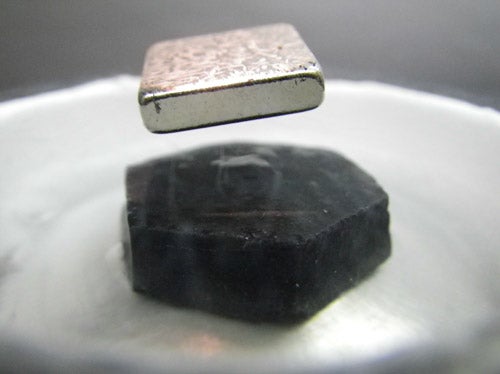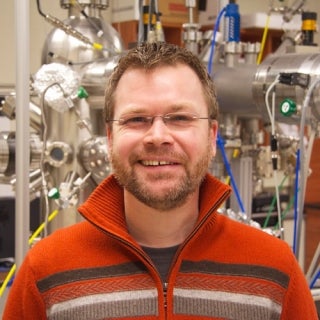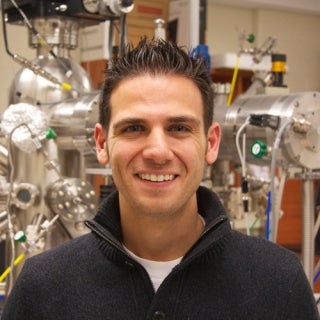
Waterloo physicists discover new properties of superconductivity
Superconductivity could have implications for creating technologies like ultra-efficient power grids and magnetically levitating vehicles

Superconductivity could have implications for creating technologies like ultra-efficient power grids and magnetically levitating vehicles
By Victoria Van Cappellen and Rose Simone University of WaterlooPhysicists at the University of Waterloo have led an international team that has come closer to understanding the mystery of how superconductivity, an exotic state that allows electricity to be conducted with practically zero resistance, occurs in certain materials.
Physicists all over the world are on a quest to understand the secrets of superconductivity because of the exciting technological possibilities that could be realized if they could make it happen at closer to room temperatures. In conventional superconductivity, materials that are cooled to nearly absolute zero ( −273.15 Celsius) exhibit the fantastic property of electrons pairing up and being able to conduct electricity with practically zero resistance. If superconductivity worked at higher temperatures, it could have implications for creating technologies such as ultra-efficient power grids, supercomputers and magnetically levitating vehicles.

The new findings from an international collaboration, led by Waterloo physicists David Hawthorn, Canada Research Chair Michel Gingras, doctoral student Andrew Achkar and post-doctoral student Zhihao Hao, present direct experimental evidence of what is known as electronic nematicity - when electron clouds snap into an aligned and directional order - in a particular type of high-temperature superconductor. The results, published in the prestigious journal Science, may eventually lead to a theory explaining why superconductivity occurs at higher temperatures in certain materials.
“In this study, we identify some unexpected alignment of the electrons – a finding that is likely generic to the high-temperature superconductors and in time may turn out be a key ingredient of the problem,” says Hawthorn, a professor in Waterloo’s Department of Physics and Astronomy.
The findings show evidence of electronic nematicity as a universal feature in cuprate high-temperature superconductors. Cuprates are copper-oxide ceramics composed of two-dimensional layers or planes of copper and oxygen atoms separated by other atoms. They are known as the best

David Hawthorn, professor in Waterloo's Department of Physics and Astronomy
of the high-temperature superconductors. In the 1980s, materials that exhibit superconductivity under somewhat warmer conditions (but still -135 Celsius, so far from room temperature) were discovered. But how superconductivity initiates in these high-temperature superconductors has been challenging to predict, let alone explain.
“It has become apparent in the past few years that the electrons involved in superconductivity can form patterns, stripes or checkerboards, and exhibit different symmetries – aligning preferentially along one direction,” says Hawthorn. “These patterns and symmetries have important consequences for superconductivity – they can compete, coexist or possibly even enhance superconductivity.”
The scientists used a novel technique called soft x-ray scattering at the Canadian Light Source synchrotron in Saskatoon to probe electron scattering in specific layers in the cuprate crystalline structure. Specifically, they looked at the individual cuprate (CuO2) planes where electronic nematicity takes place, versus the crystalline distortions in between the CuO2 planes.
Electronic nematicity happens when the electron orbitals align themselves like a series of rods. The term nematicity commonly refers to when liquid crystals spontaneously align under an electric field in liquid crystal displays. In this case, the electron orbitals enter the nematic state as the temperature drops below a critical point.
Cuprates can made to be superconducting by adding elements that will remove electrons from the material, a process known as “doping.”

Andrew Achkar, doctoral student in Waterloo's Department of Physics and Astronomy
A material can be optimally doped to achieve superconductivity at the highest and most accessible temperature, but in studying how superconductivity happens, physicists often work with material that is “underdoped,” which means the level of doping is less than the level that maximizes the superconducting temperature.
Results from this study show electronic nematicity likely occur in all underdoped cuprates.
Physicists also want to understand the relation of nematicity to a phenomenon known as charge density wave fluctuations. Normally, the electrons are in a nice, uniform distribution, but charge-ordering can cause the electrons to bunch up, like ripples on a pond. This sets up a competition, whereby the material is fluctuating between the superconducting and non-superconducting states until the temperature cools enough for the superconductivity to win.
Although there is not yet an agreed upon explanation for why electronic nematicity occurs, it may ultimately present another knob to tune in the quest to achieve the ultimate goal of a room temperature superconductor.
“Future work will tackle how electronic nematicity can be tuned, possibly to advantage, by modifying the crystalline structure,” says Hawthorn.
Hawthorn and Gingras are both Fellows of the Canadian Institute For Advanced Research. Gingras holds the Canada Research Chair in Condensed Matter Theory and Statistical Mechanics and spent time at the Perimeter Institute for Theoretical Physics as a visiting researcher while this work was being carried out.
Other Canadian collaborators include the Canadian Light Source and H. Zhang and Y.-J. Kim from the University of Toronto.

Read more
The awarded proposal seeks to understand and mitigate the loss of quantum information

Read more
Scientists recreate properties of light in neutral fundamental particles called neutrons

Read more
A new imaging technique using quantum science may lead to novel drug therapies and treatment options, a recent study has found.
The University of Waterloo acknowledges that much of our work takes place on the traditional territory of the Neutral, Anishinaabeg, and Haudenosaunee peoples. Our main campus is situated on the Haldimand Tract, the land granted to the Six Nations that includes six miles on each side of the Grand River. Our active work toward reconciliation takes place across our campuses through research, learning, teaching, and community building, and is co-ordinated within the Office of Indigenous Relations.